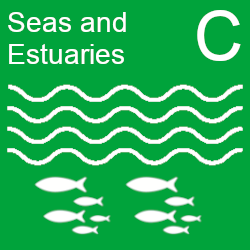Information - This Indicator is an official statistic in development and has been published in order to facilitate user involvement in its development – information on how the data have been obtained and how the indicator has been prepared is available via the link(s) in the 'Readiness and links to data' section. We would welcome any feedback, particularly on the usefulness and value of this statistic, via 25YEPindicators@defra.gov.uk.
Short Description
This indicator of diverse seas shows changes in the status of vulnerable features flagged for protection, either listed in national legislation or international agreements. These features include the features of conservation interest protected in Marine Protected Areas, Natural Environment and Rural Communities Act Section 41 habitats and species of principle importance for conservation, and under the Convention for the Protection of the Marine Environment of the North-East Atlantic (OSPAR), amongst others. The overall indicator will be derived from the status of the individual features.
Readiness and links to data
An interim indicator is presented here based upon UK-relevant information published by OSPAR, and Habitats Directive Article 17 UK marine-specific feature assessments, compiled by the Joint Nature Conservation Committee (JNCC) in the C6 indicator report (JNCC Report 794). The indicator will be updated when new status assessments become available. The indicator will be flexible, with intended scope for integration with wider datasets, where relevant data are publicly available. Where appropriate, results from different assessment periods will be shown in future updates. The data for component C6b are published as an official statistic in development to gather feedback and facilitate user involvement in the development of the indicator.
Two assessments on the status of vulnerable features have been presented here. C6a is based on the OSPAR list of Threatened and/or Declining Species and Habitats. C6a incorporated published OSPAR status assessments, where available. For species on the list that did not yet have a published status assessment, but were assessed via OSPAR Common Indicators, the Common Indicator assessment was used (relevant to harbour porpoise and roseate tern only). C6b is based on Habitats Directive Article 17 marine-specific UK status assessments (this reporting requirement has since been translated into the Habitats Regulations).
Notes on indicator
The two assessments (C6a and C6b) are not currently directly comparable. OSPAR assessments are conducted by OSPAR regional sea, whilst the Article 17 marine-specific assessments are only available at a UK-wide scale. Additionally, Article 17 assessments were conducted earlier than the OSPAR assessments, so they have been presented separately. Furthermore, the OSPAR Threatened and/or Declining list includes features that are considered to be in need of priority protection, whereas Article 17 features are considered threatened and listed on the annexes of the Habitats Directive.
Whilst most features appear in only one assessment, there is some minor overlap between the two lists. Annex I habitats are habitat complexes made up of a mosaic of subtidal and intertidal habitats, therefore multiple Threatened and/or Declining habitats potentially form part of a single Annex I listed feature. Where habitats correlate and have been assessed under both, they generally have similar assessment outcomes (poor, or unfavourable, depending on the assessment). There are also four species in both lists, but none of these have an assessment result under their Article 17 assessment, being assigned either ‘not assessed’ or ‘unknown’. They have all been given a 'poor' assessment result under their OSPAR assessment. Whilst there is a small amount of overlap, the OSPAR Threatened and/or Declining list aims to compliment, rather than duplicate, work under the other existing legislation in Northern Europe, including the Habitats and Birds directives (OSPAR Agreement 2019-04).
In 2025, additional categories were added to the chart in C6b to give further context to those features found to be in unfavourable condition. These categories reflect trend assessment results for features and show whether they are improving, deteriorating, stable, or the trend is unknown.
Indicator components
Figure C6a: Status of UK relevant OSPAR threatened and/or declining species and habitats across OSPAR Region II (Greater North Sea) and III (Celtic Seas), 2019 to 2023
Table C6a: Status of UK relevant OSPAR threatened and/or declining species and habitats across OSPAR Region II (Greater North Sea) and III (Celtic Seas), 2019 to 2023
| Regional Sea | Feature | Good | Not assessed | Poor | Unknown |
|---|---|---|---|---|---|
| II | Birds | 1 | 0 | 2 | 0 |
| II | Fish | 2 | 6 | 10 | 1 |
| II | Habitats | 0 | 4 | 8 | 1 |
| II | Invertebrates | 0 | 2 | 0 | 0 |
| II | Mammals | 0 | 0 | 2 | 0 |
| II | Reptiles | 0 | 0 | 1 | 0 |
| III | Birds | 0 | 1 | 2 | 0 |
| III | Fish | 1 | 6 | 12 | 2 |
| III | Habitats | 0 | 3 | 6 | 1 |
| III | Invertebrates | 0 | 2 | 0 | 0 |
| III | Mammals | 0 | 0 | 2 | 0 |
| III | Reptiles | 0 | 0 | 1 | 0 |
Trend description for C6a
The majority of features on OSPAR’s list of Threatened and/or Declining Species and Habitats are in poor status in both the Greater North Sea and Celtic Seas regions.
This includes all three of the mammal and reptile species. For birds, two out of three assessed species were in poor status in the Greater North Sea and two out of two assessed species in the Celtic Seas. Of the fish species assessed, 10 of 13 in the Greater North Sea and 12 of 15 in the Celtic Seas are in poor status.
The only features in good status are two fish species in the Greater North Sea, one fish species in the Celtic Seas and one bird species in the Greater North Sea.
Habitats have similar assessment results with eight of nine assessed habitats, and six of seven assessed habitats being in poor status in the Greater North Sea and Celtic Seas, respectively. The status of the remainder of the assessed habitats on the list is unknown.
There are features included on the OSPAR Threatened and/or Declining Species and Habitats list that have not been assessed, these include eight species and four habitats in the Greater North Sea and nine species and three habitats in the Celtic Seas. None of the listed invertebrates in the Greater North Sea or Celtic Seas have been assessed.
Assessment of change
No assessment of change was undertaken for this indicator as a suitable time series is not yet available in the Outcome Indicator Framework.
Figure C6b: Status of Habitats Directive Article 17 listed coastal and marine features in the UK, 2019
Table C6b: Status of Habitats Directive Article 17 listed coastal and marine features in the UK, 2019
| Category | Favourable | Unfavourable - Declining | Unfavourable - Stable | Unfavourable - Unknown | Unknown |
|---|---|---|---|---|---|
| Habitat (coastal) | 0 | 3 | 3 | 2 | 0 |
| Habitat (marine) | 0 | 0 | 3 | 5 | 1 |
| Mammal | 1 | 0 | 0 | 1 | 11 |
| Reptile | 0 | 0 | 0 | 0 | 1 |
Trend description for C6b
Most of the marine and coastal habitats listed under Article 17 of the Habitats Directive which have been assessed at a UK scale are in Unfavourable condition (eight of eight coastal, and eight of nine marine). The status of the remaining assessed marine habitat is unknown. Three of the coastal habitats assessed are in Unfavourable-Declining condition. No features are in the Unfavourable-Improving category. Of the marine mammal species assessed, one is in Favourable condition, one is in Unfavourable-Unknown condition, and the remaining 11 mammals on the list are in Unknown status. One reptile was assessed as unknown.
Assessment of change
No assessment of change was undertaken for this indicator as a suitable time series is not yet available in the Outcome Indicator Framework.

